Step 4. Implement the Ping SDK
Now that you have the environment and servers setup you can build the Ping SDK into the app to handle callbacks, display UI, and other tasks.
Set configuration from the ENV file
Within your IDE of choice, navigate to the sdk-sample-apps/angular-todo directory. This directory is where you will spend the rest of your time.
First, open up the src/app/app.component.ts file, import the Config object from the Ping SDK for JavaScript and call the set function on this object.
To import the Config object, modify the list of imports as follows:
import { Component, OnInit } from '@angular/core';
import { environment } from '../environments/environment';
import { UserService } from './services/user.service';
+ import { Config, UserManager } from '@forgerock/javascript-sdk';
@@ collapsed @@Now configure the SDK using the set function by adding the following code to the ngOnInit function:
@@ collapsed @@
async ngOnInit(): Promise<void> {
+ Config.set({
+ clientId: environment.WEB_OAUTH_CLIENT,
+ redirectUri: environment.APP_URL,
+ scope: 'openid profile email address',
+ serverConfig: {
+ baseUrl: environment.AM_URL,
+ timeout: 30000, // 90000 or less
+ },
+ realmPath: environment.REALM_PATH,
+ tree: environment.JOURNEY_LOGIN,
+ });
@@ collapsed @@The use of set() should always be the first SDK method called and is frequently done at the application’s top-level file.
To configure the SDK to communicate with the journeys, OAuth clients, and realms of the appropriate server, pass a configuration object with the appropriate values.
The configuration object you are using in this instance pulls most of its values out of the .env variables you previously setup.
The variables map to constants within the environment.ts file generated when the project is built.
Go back to your browser and refresh the home page. There should be no change to what’s rendered, and no errors in the console. Now that the app is configured to your server, let’s wire up the simple login page!
Build the login page
Consider how the application renders the home page:
HomeComponent consists of src/app/views/home/home.component.html (HTML template with Angular directives), and src/app/views/home/home.component.ts (Angular component).
For the login page, the same pattern applies:
LoginComponent consists of src/app/views/login/login.component.html and src/app/views/login/login.component.ts.
This is a simple view component, which includes FormComponent which actually invokes the SDK - more on that shortly.
Navigate to the app’s login page within your browser. You should see a "loading" spinner and message that’s persistent since it doesn’t have the data needed to render the form. To ensure the correct form is rendered, the initial data needs to be retrieved from the server. That is the first task.
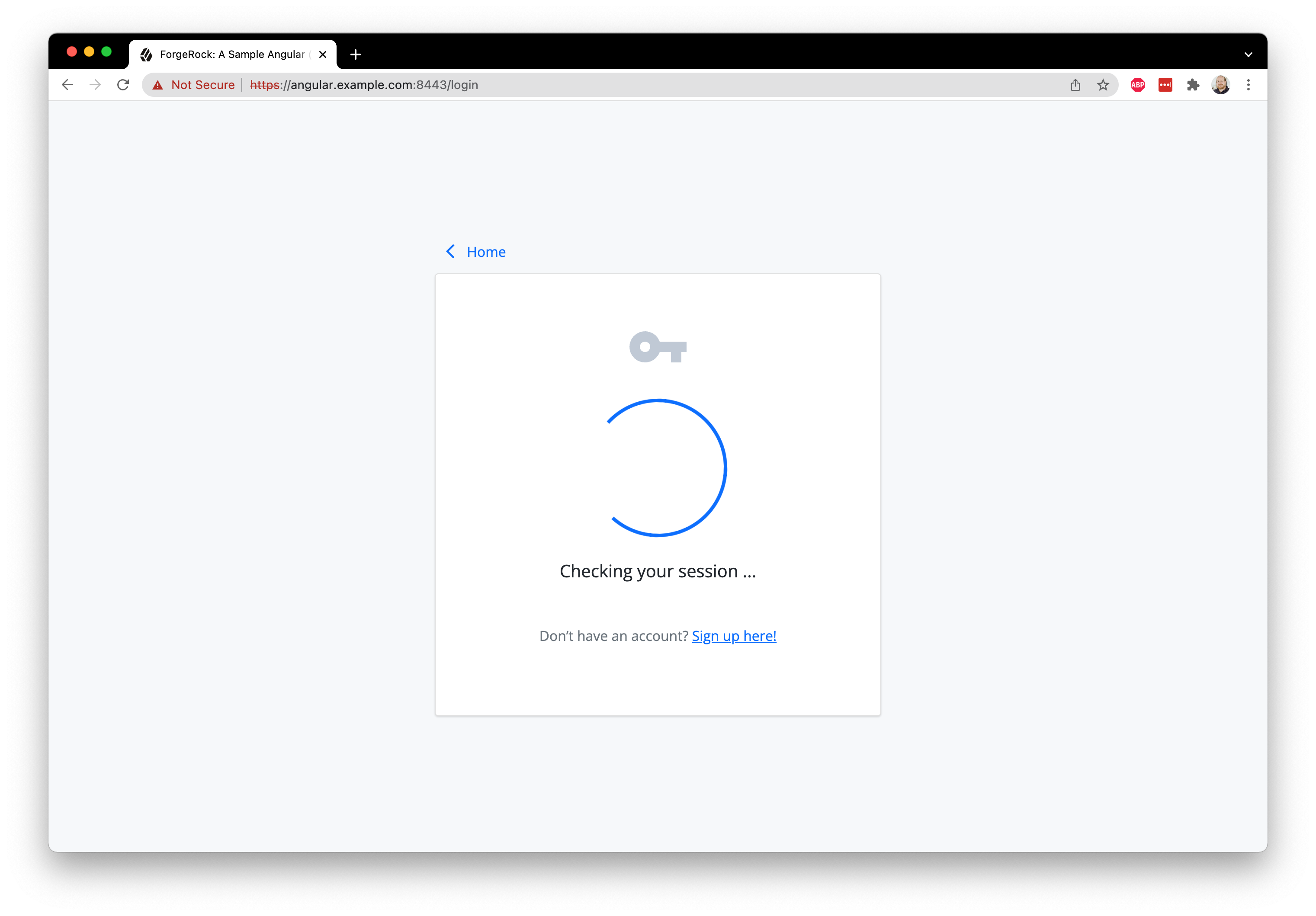
Since most of the action is taking place in src/app/features/journey/form/form.component.html and src/app/features/journey/form/form.component.ts, open both and add the SDK import to form.component.ts:
import { Component, Input, OnInit } from '@angular/core';
import { Router } from '@angular/router';
import { environment } from '../../../../environments/environment';
import { UserService } from 'src/app/services/user.service';
- import { FRLoginFailure, FRLoginSuccess, FRStep } from '@forgerock/javascript-sdk';
+ import { FRAuth, FRLoginFailure, FRLoginSuccess, FRStep } from '@forgerock/javascript-sdk';
@@ collapsed @@FRAuth is the first object used as it provides the necessary methods for authenticating a user against the Login Journey/Tree.
Use the start() method of FRAuth as it returns data we need for rendering the form.
Add the following code to the nextStep function to call the start function, initiating the authentication attempt using the SDK:
@@ collapsed @@
async nextStep(step?: FRStep): Promise<void> {
this.submittingForm = true;
+ try {
+ let nextStep = await FRAuth.next(step, { tree: this.tree });
+ } catch (err) {
+ console.log(err);
+ } finally {
+ this.submittingForm = false;
+ }
}
@@ collapsed @@The result of this initial request is stored in a variable named nextStep.
We now need to work out whether this is a login failure, success, or step with instructions for what needs to be rendered to the user for input collection.
To handle these outcomes, add the following code after the code you added above:
@@ collapsed @@
async nextStep(step?: FRStep): Promise<void> {
this.submittingForm = true;
try {
let nextStep = await FRAuth.next(step, { tree: this.tree });
+ switch (nextStep.type) {
+ case 'LoginFailure':
+ this.handleFailure(nextStep);
+ break;
+ case 'LoginSuccess':
+ this.handleSuccess(nextStep);
+ break;
+ case 'Step':
+ this.handleStep(nextStep);
+ break;
+ default:
+ this.handleFailure();
+ }
} catch (err) {
console.log(err);
} finally {
this.submittingForm = false;
}
}
@@ collapsed @@Since the nextStep type is likely a Step with instructions for rendering and collecting user input, we call the handleStep() function.
We also set the step variable on the component ready for the template to process.
To process the step, we build a form that uses the *ngFor and ngSwitch directives to iterate over the callbacks and switch based on the callback type.
This lets us use the appropriate component to render something to the user.
Once the user provides their input and submits the form, we catch the submission and invoke the nextStep function again.
So starting with the form submission, we add the following code inside the <div id="callbacks"> tag in the FormComponent template (src/app/features/journey/form/form.component.html)
@@ collapsed @@
<div id="callbacks">
+ <form #callbackForm (ngSubmit)="nextStep(step)" ngNativeValidate class="cstm_form">
+ <app-button [buttonText]="buttonText" [submittingForm]="submittingForm">
+ </app-button>
+ </form>
</div>
@@ collapsed @@The form should now catch submissions.
To iterate through the callbacks, add the following code inside the <form> tag you just added, just before the <app-button> tag:
@@ collapsed @@
<div id="callbacks">
<form #callbackForm (ngSubmit)="nextStep(step)" ngNativeValidate class="cstm_form">
+ <div *ngFor="let callback of step?.callbacks" v-bind:key="callback.payload._id">
+ </div>
<app-button [buttonText]="buttonText" [submittingForm]="submittingForm">
</app-button>
</form>
</div>
@@ collapsed @@To switch based on the type of the callback, add the following code within the <div> tag you just added:
@@ collapsed @@
<div *ngFor="let callback of step?.callbacks" v-bind:key="callback.payload._id">
+ <container-element [ngSwitch]="callback.getType()">
+ </container-element>
</div>
@@ collapsed @@Finally, to render something appropriate to the user based on the callback type (and handle unknown callbacks), add the below code within the <container-element> tag you just added.
@@ collapsed @@
<container-element [ngSwitch]="callback.getType()">
+ <app-text *ngSwitchCase="'NameCallback'" [callback]="$any(callback)" [name]="callback?.payload?.input?.[0]?.name" (updatedCallback)="$any(callback).setName($event)">
+ </app-text>
+ <app-password *ngSwitchCase="'PasswordCallback'" [callback]="$any(callback)" [name]="callback?.payload?.input?.[0]?.name" (updatedCallback)="$any(callback).setPassword($event)">
+ </app-password>
+ <app-unknown *ngSwitchDefault [callback]="callback"></app-unknown>
</container-element>
@@ collapsed @@Refresh the page, and you should now have a dynamic form that reacts to the callbacks returned from our initial call to PingAM or PingOne Advanced Identity Cloud.
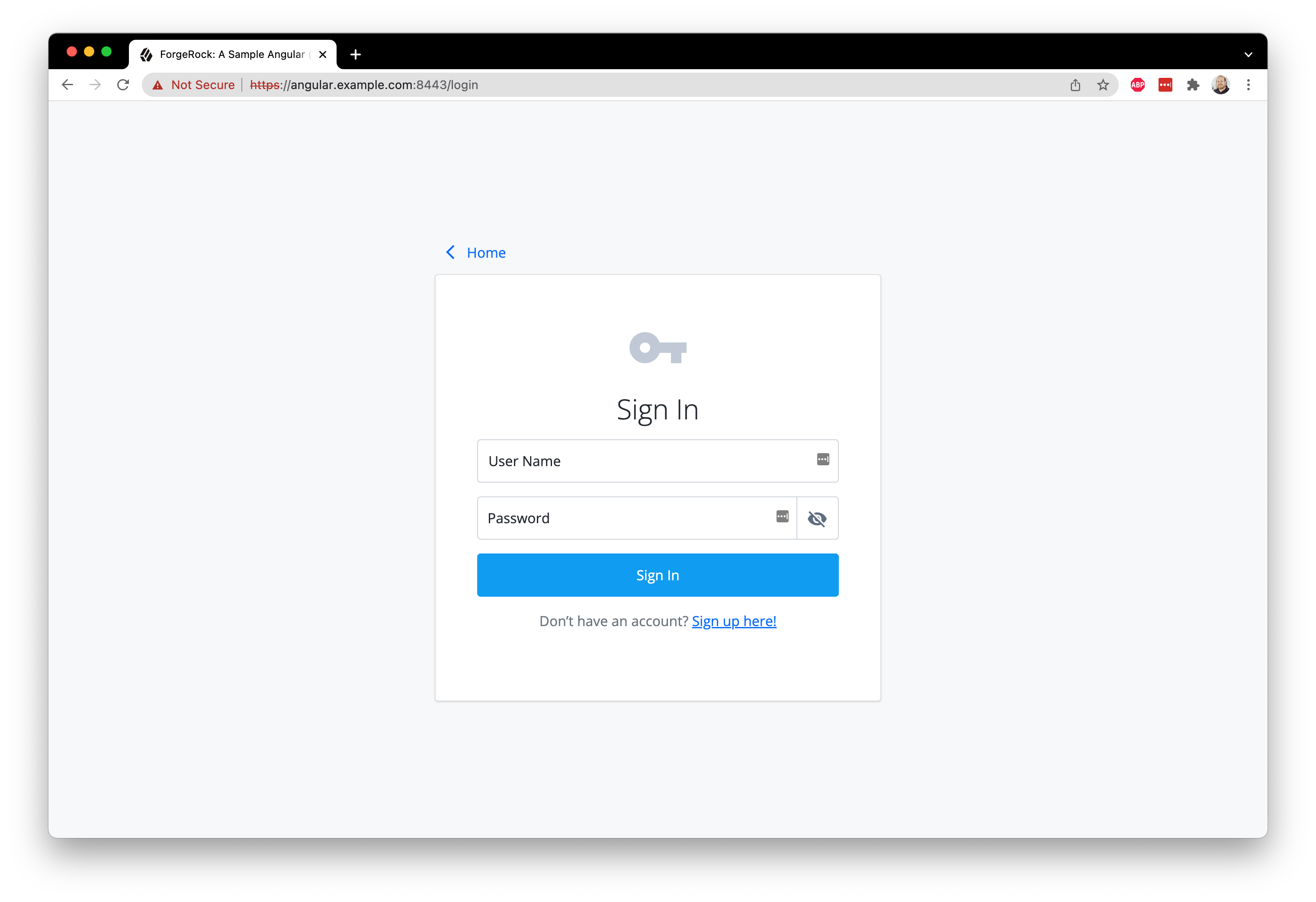
Refresh the login page and use the test user to login.
You should get a mostly blank login page if the user’s credentials are valid and the journey completes.
You can verify this by going to the Network panel within the developer tools and inspecting the last /authenticate request.
It should have a tokenId and successUrl property.
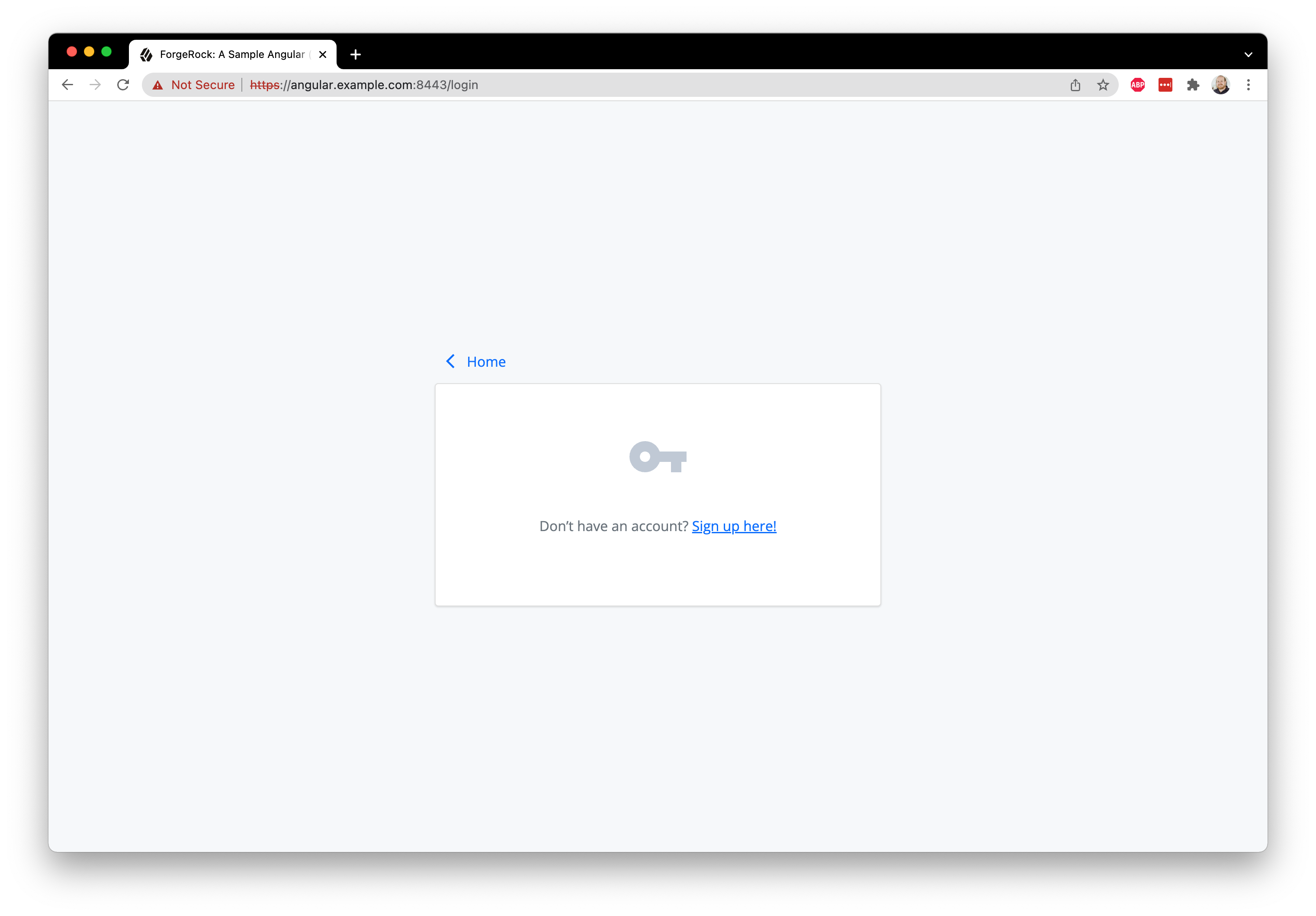
You may ask, “How are the user’s input values added to the step object?” Let’s take a look at the component for rendering the username input.
Open up the Text component: src/app/features/journey/text/text.component.ts and src/app/features/journey/text/text.component.html:
<input
@@ collapsed @@
(input)="updateValue($event)"
@@ collapsed @@
/>When the user changes the value of the input, the (input) event fires and calls updateValue().
This in turn uses the EventEmitter defined in the @Output directive to emit the updated value to the parent component - in this case, the FormComponent.
From here, the FormComponent calls the appropriate convenience method in the SDK to set the value for the callback.
This final piece is shown below (this is already in your project so no need to copy it):
<app-text *ngSwitchCase="'NameCallback'" [callback]="$any(callback)" [name]="callback?.payload?.input?.[0]?.name" (updatedCallback)="$any(callback).setName($event)"
</app-text>Each callback type has its own collection of methods for getting and setting data in addition to a base set of generic callback methods. The SDK automatically adds these methods to the callback prototype. For more information about these callback methods, see our API documentation^, or the source code in GitHub, for more details.
Now that the form is rendering and submitting, add conditions to the FormComponent template (src/app/features/journey/form/form.component.html), to handle the success and error response from PingAM or PingOne Advanced Identity Cloud.
This code should be inserted towards the top of the file, inside the <ng-container> tag:
<ng-container
[ngTemplateOutlet]="success ? successMessage : failure ? failureMessage : step ? callbacks : loading"
>
<ng-template #successMessage>
+ <app-loading [message]="'Success! Redirecting ...'"></app-loading>
</ng-template>
<ng-template #failureMessage>
+ <app-alert [message]="failure?.getMessage()" [type]="'error'"></app-alert>
</ng-template>
@@ collapsed @@Once you handle the success and error condition, return back to the browser and remove all cookies created from any previous logins. Refresh the page and login with your test user created in the Setup section above. You should see a “Success!” alert message. Congratulations, you are now able to authenticate users!
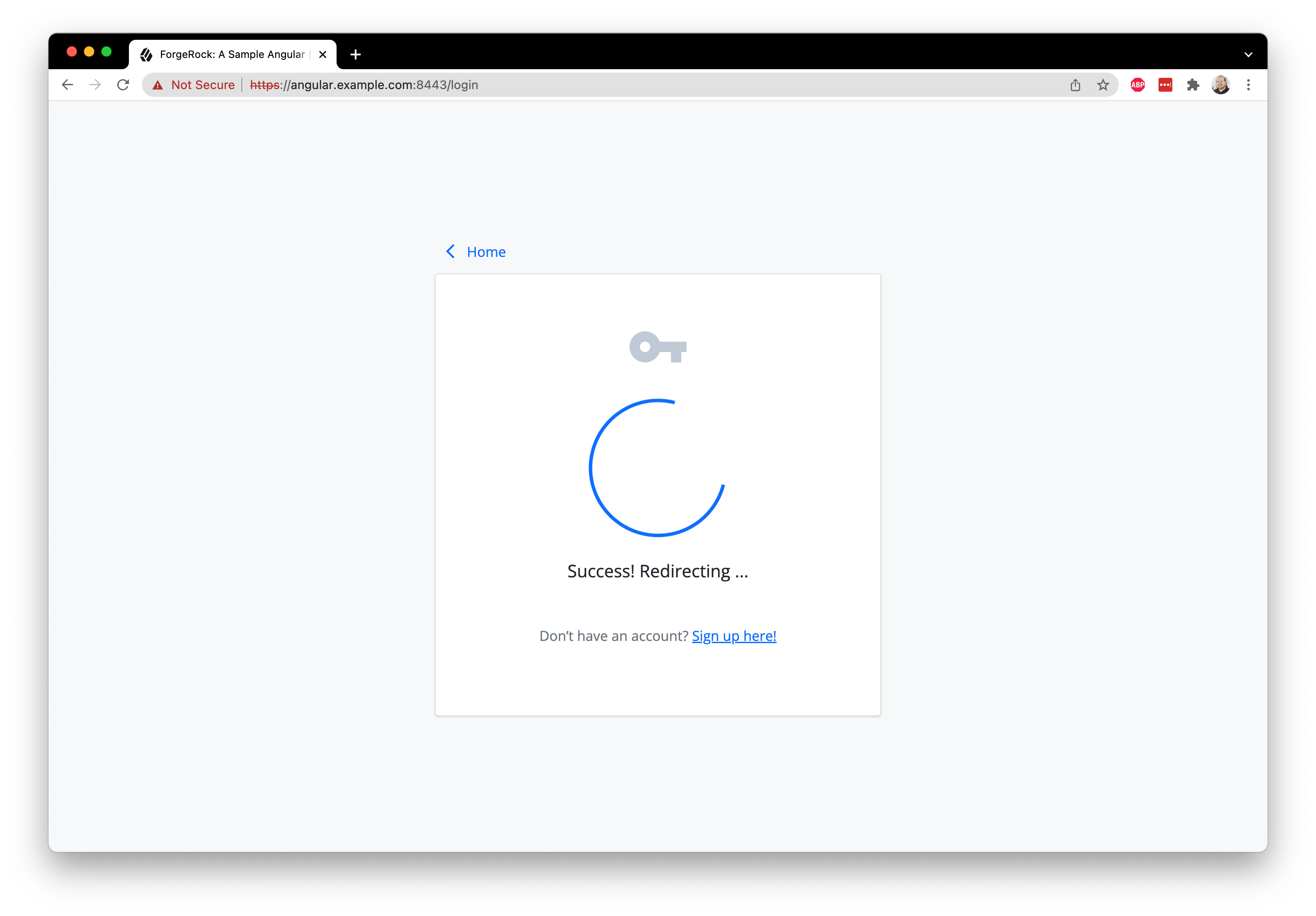
Continue to the OAuth 2.0 flow
At this point, the user is authenticated. The session has been created and a session cookie has been written to the browser. This is "session-based authentication", and is viable when your system (apps and services) can rely on cookies as the access artifact. However, there are increasing limitations with the use of cookies. In response to this, and other reasons, it’s common to add an additional step to your authentication process: the “OAuth” or “OIDC flow”.
The goal of this flow is to attain a separate set of tokens, replacing the need for cookies as the shared access artifact. The two common tokens are the access token and the ID Token. We focus on the access token in this guide. The specific flow that the SDK uses to acquire these tokens is called the Authorization Code Flow with PKCE.
To start, import the TokenManager and UserManager objects from the Ping SDK into the same src/app/features/journey/form.component.ts file - replace the import you added earlier with the following code:
import { Component, Input, OnInit } from '@angular/core';
import { Router } from '@angular/router';
import { environment } from '../../../../environments/environment';
import { UserService } from 'src/app/services/user.service';
- import { FRAuth, FRLoginFailure, FRLoginSuccess, FRStep } from '@forgerock/javascript-sdk';
+ import { FRAuth, FRLoginFailure, FRLoginSuccess, FRStep, TokenManager, UserManager, } from '@forgerock/javascript-sdk';
@@ collapsed @@In addition to the components that we were already importing, we have now imported the TokenManager and UserManager from the SDK.
Only an authenticated user that has a valid session can successfully request OAuth/OIDC tokens.
We must therefore make sure we make this asynchronous token request after we get a 'LoginSuccess' back from the authentication journey.
In the code we wrote in the previous section, our processing of the response means that a 'LoginSuccess' results in a call to the currently-empty function handleSuccess.
Let’s invoke the OAuth 2.0 flow from here.
Note that since the getTokens request is asynchronous, handleSuccess has been marked async.
Add the following code to the try block within handleSuccess to start the flow:
@@ collapsed @@
async handleSuccess(success?: FRLoginSuccess) {
this.success = success;
+ try {
+ await TokenManager.getTokens({ forceRenew: true });
+ } catch (err) {
+ console.error(err);
+ }
}
@@ collapsed @@Once the changes are made, return back to your browser and remove all cookies created from any previous logins. Refresh the page and verify the login form is rendered. If the success message continues to display, make sure “third-party cookies” are also removed.
Login with your test user.
You should get a success message like you did before, but now check your browser’s console log.
You should see an additional entry of an object that contains your idToken and accessToken.
Since the SDK handles storing these tokens for you, which are in localStorage, you have completed a full login and OAuth/OIDC flow.
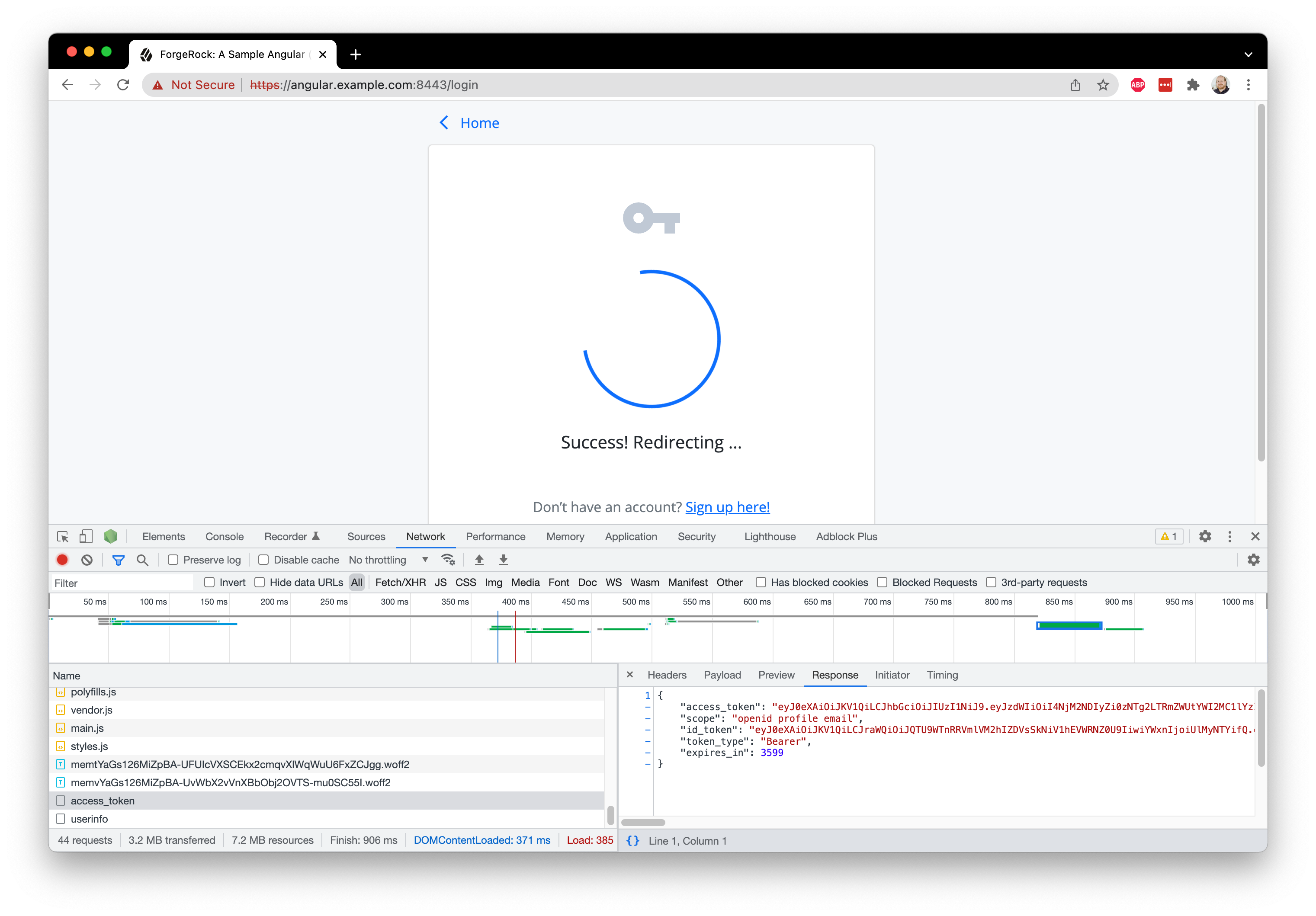
Request user information
Now that the user is authenticated and an access token is attained, you can now make your first authenticated request.
The SDK provides a convenience method for calling the /userinfo endpoint, a standard OAuth endpoint for requesting details about the current user. The data returned from this endpoint correlates with the "scopes" set within the SDK configuration.
The scopes profile and email allow the inclusion of user’s first and last name as well as their email address.
To retrieve user information, add another single line of code to invoke the getCurrentUser() function of the SDK, underneath the getTokens() call:
@@ collapsed @@
async handleSuccess(success?: FRLoginSuccess) {
this.success = success;
try {
await TokenManager.getTokens({ forceRenew: true });
+ let info = await UserManager.getCurrentUser();
} catch (err) {
console.error(err);
}
}
@@ collapsed @@We want to store the fact that the user is authenticated, together with the user information we retrieved, in a state that can be shared with other Angular components in our app.
To do this, we have injected the service UserService into FormComponent.
This service is also injected into other components that should need access to authentication status and user information.
To update the UserService and redirect the user to the home page, add the following code below the getCurrentUser() call:
@@ collapsed @@
async handleSuccess(success?: FRLoginSuccess) {
this.success = success;
try {
await TokenManager.getTokens({ forceRenew: true });
let info = await UserManager.getCurrentUser();
+ this.userService.info = info;
+ this.userService.isAuthenticated = true;
+ this.router.navigateByUrl('/');
} catch (err) {
console.error(err);
}
}
@@ collapsed @@Revisit the browser, clear out all cookies, storage and cache, and log in with your test user.
Once you have landed on the home page you should notice that the page looks slightly different with an added success alert and message with the user’s full name.
This is due to the app “reacting” to the state in the UserService that we set just before the redirection.
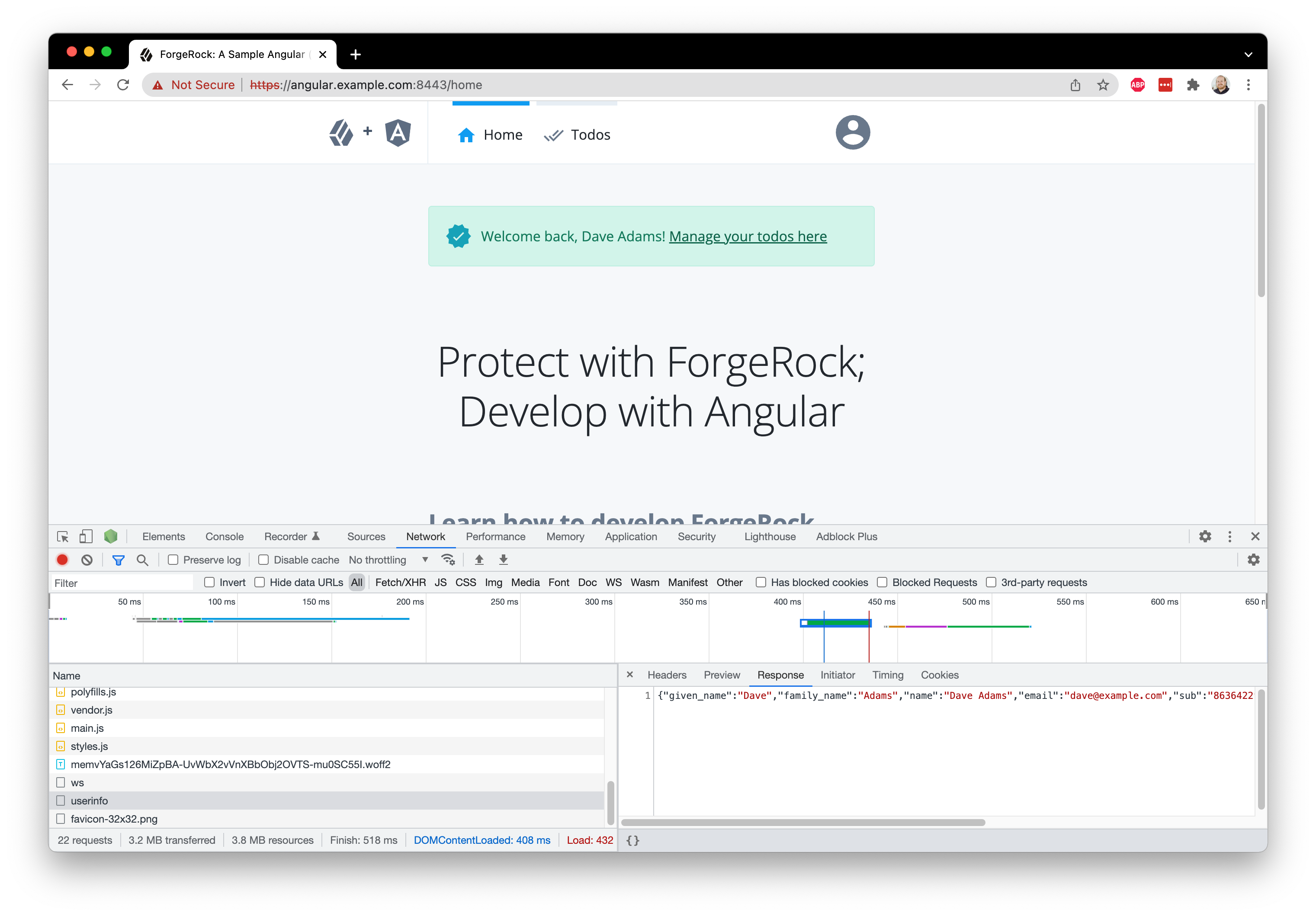
React to the presence of the access token
To ensure your app provides a good user-experience, it’s important to have a recognizable, authenticated experience, even if the user refreshes the page or closes and reopens the browser tab. This makes it clear to the user that they are logged in.
Currently, if you refresh the page, the authenticated experience is lost. Let’s fix that!
If the user is logged in, there are tokens in the browser.
To ensure the tokens are valid and the user information is available to the rest of the page, we use the getCurrentUser() function of the SDK.
The function determines if the tokens are still valid.
The function also retrieves the user information for use in the rest of the app.
To do this, add the following code to the ngOnInit() function in the main component - src/app/app.component.ts.
This should provide what we need to re-initialise the user’s authentication status:
@@ collapsed @@
async ngOnInit(): Promise<void> {
Config.set({
clientId: environment.WEB_OAUTH_CLIENT,
redirectUri: environment.APP_URL,
scope: 'openid profile email address',
serverConfig: {
baseUrl: environment.AM_URL,
timeout: 30000, // 90000 or less
},
realmPath: environment.REALM_PATH,
tree: environment.JOURNEY_LOGIN,
});
+ try {
+ const tokens: Tokens = await TokenStorage.get();
+ if (tokens !== undefined) {
+ // Assume user is likely authenticated if there are tokens
+ const info = await UserManager.getCurrentUser();
+ this.userService.isAuthenticated = true;
+ this.userService.info = info;
+ }
+ } catch (err) {
+ // User likely not authenticated
+ console.log(err);
+ }
}
@@ collapsed @@With a global state API available to the app using UserService, different components can pull this state in and use it to conditionally render a set of UI elements.
Navigation elements and the displaying of profile data are good examples of such conditional rendering.
Examples of this can be found by reviewing src/app/layout/header/header.component.ts and src/app/views/home/home.component.ts.
Validate the access token
The presence of the access token can be a good hint for authentication, but it doesn’t mean the token is actually valid. Tokens can expire or be revoked on the server-side.
We are now focusing on protecting a particular page in our app (todos), so we may want to be sure that the user has valid tokens.
We are currently just checking that there are tokens in the browser and redirecting to the login page.
This is a reasonable approach and is quick since there are no network requests involved.
However we have no assurance that the tokens are still valid.
We could ensure that the tokens are still valid with the use of getCurrentUser() method as we do in the main component.
However as this now requires a network request to complete before the page loads, it could impact on the speed at which the page loads.
This is a decision that you must make for your implementation, depending on your requirements.
In this example, instead of just checking for presence of tokens, we prioritize security over speed by making sure that the token is valid before the page is rendered.
To protect a route by ensuring the user has a valid access token, open the src/app/auth/auth.guard.ts file which uses the CanActivate interface, and import the UserManager from the SDK:
@@ collapsed @@
import { UserService } from '../services/user.service';
- import { Tokens, TokenStorage } from '@forgerock/javascript-sdk';
+ import { Tokens, TokenStorage, UserManager } from '@forgerock/javascript-sdk';
@@ collapsed @@Then, replace the code within canActivate as follows:
@@ collapsed @@
// Assume user is likely authenticated if there are tokens
const tokens: Tokens = await TokenStorage.get();
+ const info = await UserManager.getCurrentUser();
- if (tokens === undefined) {
+ if (tokens === undefined || info === undefined) {
return loginUrl;
@@ collapsed @@Revisit the browser and refresh the page. Navigate to the Todos page. You should notice a quick spinner and text communicating that the app is "verifying access". Once the server responds, the Todos page renders. The consequence of this is the protected route now has to wait for the server to respond, but the user’s access has been verified by the server.
Request protected resources with an access token
Once the Todos page renders, notice how the the Todo collection appears empty.
This is due to the request function in the TodoService being incomplete.
To make resource requests to a protected endpoint, we have an HttpClient module that provides a simple wrapper around the native fetch() method of the browser.
When you call the request() method, it should retrieve the user’s access token, and attach it as a Bearer Token to the request as an authorization header.
This is what the resource server uses to make its own request to the server to validate the user’s access token.
All requests to the Todos backend live in the TodoService, which is injected into the TodosComponent which renders the /todos page.
Each of the functions dedicated to a particular backend request, call the convenience function request(), which needs to use the Ping SDK HttpClient.
To use the HttpClient, add the following import statement to the top of src/app/services/todo.service.ts:
import { Injectable } from '@angular/core';
import { Todo } from '../features/todo/todo';
import { environment } from '../../environments/environment';
+ import { HttpClient } from '@forgerock/javascript-sdk';
@@ collapsed @@Now, complete the request() function to use the HttpClient to make requests to the Todos backend - replace the existing return statement with the following:
@@ collapsed @@
request(resource: string, method: string, data?: Todo): Promise<Response> {
- return new Promise((resolve, reject) => reject('Method not implemented'));
+ return HttpClient.request({
+ url: resource,
+ init: {
+ headers: {
+ 'Content-Type': 'application/json',
+ },
+ body: JSON.stringify(data),
+ method: method,
+ },
+ timeout: 5000,
+ });
}
@@ collapsed @@At this point, the user can login, request access tokens, and access the page of the protected resources (todos). Now, revisit the browser and clear out all cookies, storage, and cache. Keeping the developer tools open and on the network tab, log in with you test user. Once you have been redirected to the home page, do the following:
-
Click on the “Todos” item in the navigation bar - you should see that a lot of network activity should be listed.
-
Find the network call to the
/todosendpoint (http://localhost:9443/todos). -
Click on that network request and view the request headers.
-
Notice the
authorizationheader with the bearer token; that’s theHttpClientin action.
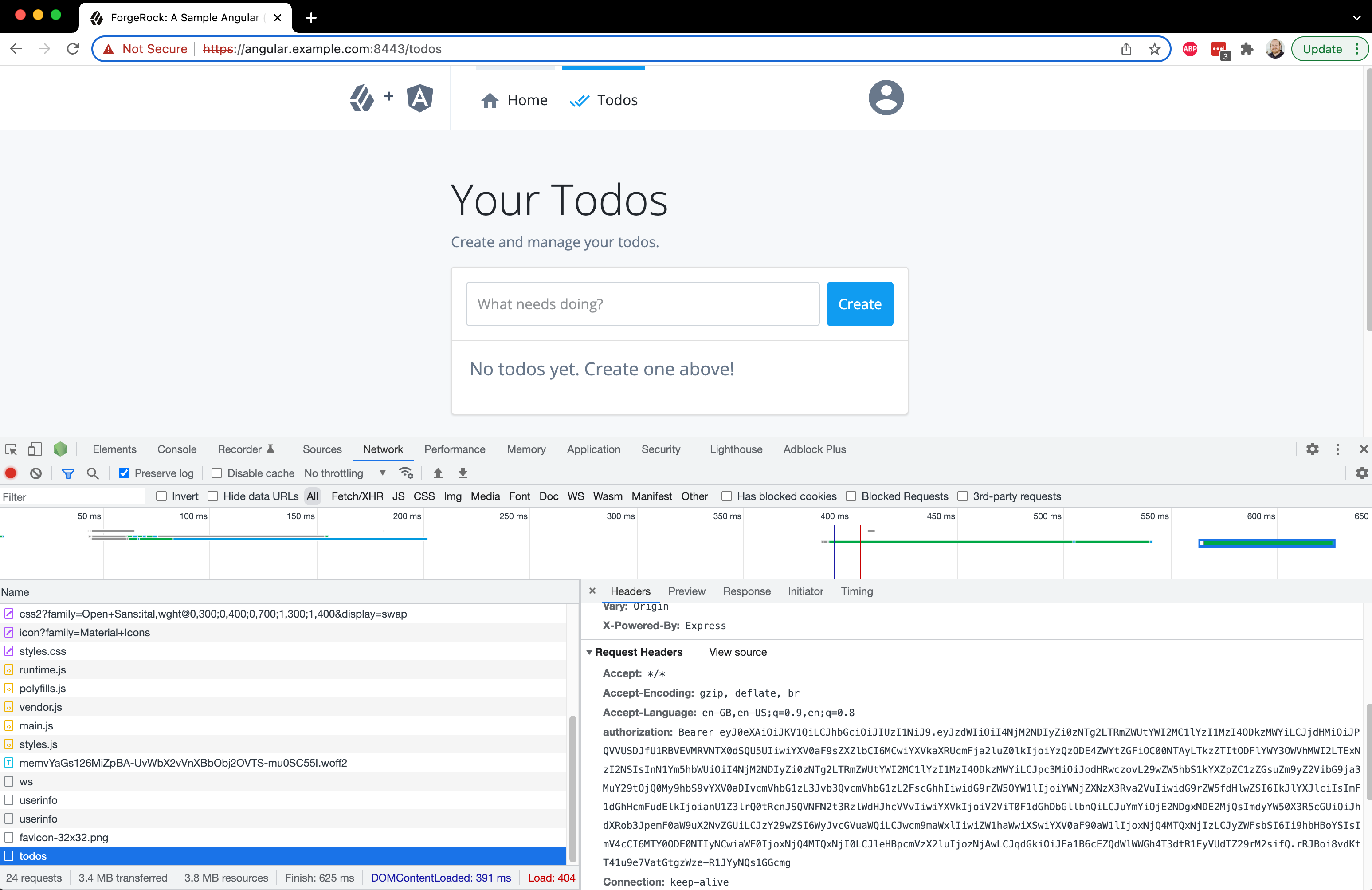
Handle logout request
Of course, you can’t have a protected app without providing the ability to log out. Luckily, this is a fairly easy task using the SDK.
Open up the LogoutComponent file src/app/features/logout/logout.component.ts and import FRUser from the Ping SDK:
@@ collapsed @@
import { Component, OnInit } from '@angular/core';
import { Router } from '@angular/router';
import { UserService } from '../../services/user.service';
+ import { FRUser } from '@forgerock/javascript-sdk';
@@ collapsed @@Logging the user out and revoking their tokens is easy using the logout() function of FRUser.
Once this async call returns, we then remove any user information from UserService (and therefore other parts of the application since this is injected in other components).
To do this, add the following code to logout():
@@ collapsed @@
async logout() {
+ try {
+ await FRUser.logout();
+ this.userService.info = undefined;
+ this.userService.isAuthenticated = false;
+ setTimeout(() => this.redirectToHome(), 1000);
+ } catch (err) {
+ console.error(`Error: logout did not successfully complete; ${err}`);
+ }
}
@@ collapsed @@Test the app
To test the app return to your browser, empty the local storage and cache, and reload the page.
You should now be able to log in with the demo user, navigate to the Todos page, add and edit some "Todos", and logout by selecting the profile icon in the top-right and clicking Sign Out.
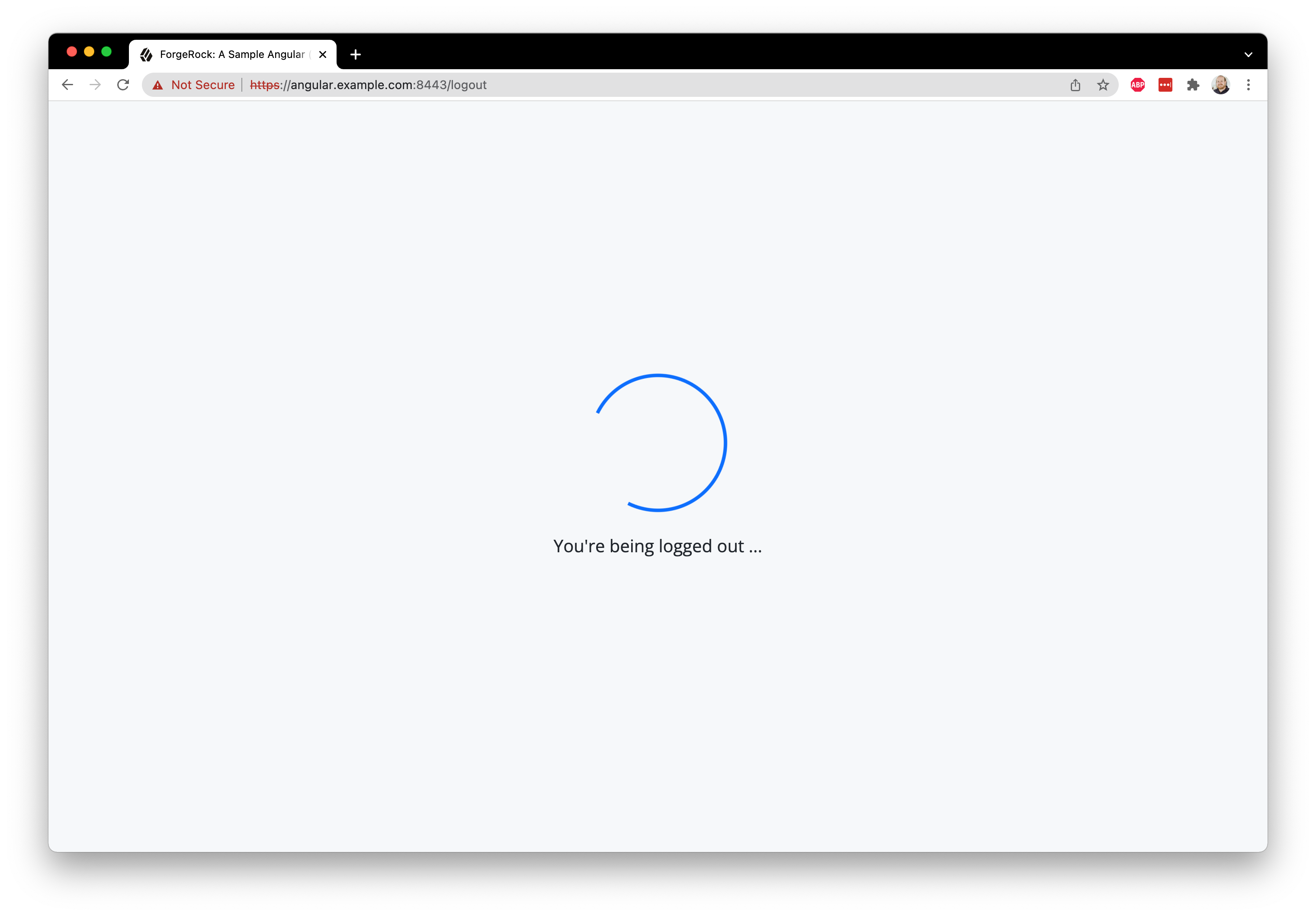
Congratulations, you just built a protected app with Angular!